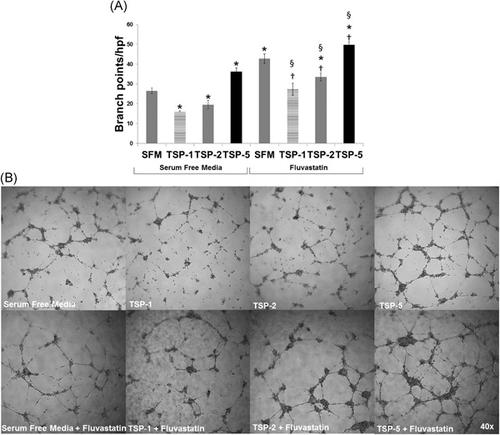当前位置:
X-MOL 学术
›
J. Cell. Biochem.
›
论文详情
Our official English website, www.x-mol.net, welcomes your
feedback! (Note: you will need to create a separate account there.)
Thrombospondin-5 and fluvastatin promote angiogenesis and are protective against endothelial cell apoptosis.
Journal of Cellular Biochemistry ( IF 3.0 ) Pub Date : 2020-04-29 , DOI: 10.1002/jcb.29686 Furqan Muqri 1, 2 , Alex Helkin 1, 2 , Kristopher G Maier 1, 2 , Vivian Gahtan 1, 2
Journal of Cellular Biochemistry ( IF 3.0 ) Pub Date : 2020-04-29 , DOI: 10.1002/jcb.29686 Furqan Muqri 1, 2 , Alex Helkin 1, 2 , Kristopher G Maier 1, 2 , Vivian Gahtan 1, 2
Affiliation

|
The thrombospondins (TSPs), multifunctional matricellular proteins, are known mediators of endothelial cell (EC) angiogenesis and apoptosis. TSP‐1, an antiangiogenic molecule, is important in the progression of vascular disease, in part by inducing EC apoptosis. TSP‐2, although less studied, also induces EC apoptosis and inhibits angiogenesis. The effects of TSP‐5 are largely unexplored in ECs, but TSP‐5 is believed to be protective against arterial disease. Statin drugs have been shown to have beneficial pleiotropic effects, including decreasing EC apoptosis, increasing angiogenesis, and blocking TSP signaling. We hypothesized TSP‐5 will be proangiogenic and antiapoptotic, and statin pretreatment would reverse the proapoptotic and antiangiogenic phenotype of TSP‐1 and TSP‐2. ECs were exposed to serum‐free medium, TSP‐1, TSP‐2, or TSP‐5 with or without fluvastatin pretreatment. Quantitative real‐time polymerase chain reaction was performed on 96 apoptosis and 96 angiogenesis‐related genes using microfluidic card assays. Angiogenesis was measured using Matrigel assays, while apoptosis was measured by fluorescent caspase assay. TSP‐5 suppressed apoptotic genes and had a mixed effect on the angiogenic genes; however, TSP‐5 did not alter apoptois but was proangiogenic. Pretreatment with fluvastatin downregulated proapoptotic genes and apoptosis and upregulated proangiogenic genes and angiogenesis. Findings indicate TSP‐5 and fluvastatin have a protective effect on ECs, being proangiogenic and reversing the antiangiogenic effects of TSP‐1 and TSP‐2. In conclusion, TSP‐5 and fluvastatin may be beneficial for inducing angiogenesis in the setting of ischemia.
中文翻译:

Thrombospondin-5 和氟伐他汀可促进血管生成并防止内皮细胞凋亡。
血小板反应蛋白 (TSP) 是一种多功能基质细胞蛋白,是内皮细胞 (EC) 血管生成和凋亡的已知介质。 TSP-1 是一种抗血管生成分子,在血管疾病的进展中发挥重要作用,部分原因是诱导 EC 凋亡。 TSP-2 虽然研究较少,但也能诱导 EC 凋亡并抑制血管生成。 TSP-5 在 EC 中的作用在很大程度上尚未被探索,但 TSP-5 被认为可以预防动脉疾病。他汀类药物已被证明具有有益的多效性作用,包括减少 EC 凋亡、增加血管生成和阻断 TSP 信号传导。我们假设 TSP-5 具有促血管生成和抗凋亡作用,而他汀类药物预处理会逆转 TSP-1 和 TSP-2 的促凋亡和抗血管生成表型。 ECs 暴露于无血清培养基、TSP-1、TSP-2 或 TSP-5,有或没有氟伐他汀预处理。使用微流控卡检测对 96 个细胞凋亡和 96 个血管生成相关基因进行定量实时聚合酶链反应。使用基质胶测定来测量血管生成,而通过荧光半胱天冬酶测定来测量细胞凋亡。 TSP-5 抑制凋亡基因并对血管生成基因产生混合效应;然而,TSP-5 并不改变细胞凋亡,而是促血管生成。氟伐他汀预处理下调促凋亡基因和细胞凋亡,上调促血管生成基因和血管生成。研究结果表明,TSP-5 和氟伐他汀对 EC 具有保护作用,具有促血管生成作用,并逆转 TSP-1 和 TSP-2 的抗血管生成作用。总之,TSP-5 和氟伐他汀可能有利于在缺血情况下诱导血管生成。
更新日期:2020-04-29
中文翻译:

Thrombospondin-5 和氟伐他汀可促进血管生成并防止内皮细胞凋亡。
血小板反应蛋白 (TSP) 是一种多功能基质细胞蛋白,是内皮细胞 (EC) 血管生成和凋亡的已知介质。 TSP-1 是一种抗血管生成分子,在血管疾病的进展中发挥重要作用,部分原因是诱导 EC 凋亡。 TSP-2 虽然研究较少,但也能诱导 EC 凋亡并抑制血管生成。 TSP-5 在 EC 中的作用在很大程度上尚未被探索,但 TSP-5 被认为可以预防动脉疾病。他汀类药物已被证明具有有益的多效性作用,包括减少 EC 凋亡、增加血管生成和阻断 TSP 信号传导。我们假设 TSP-5 具有促血管生成和抗凋亡作用,而他汀类药物预处理会逆转 TSP-1 和 TSP-2 的促凋亡和抗血管生成表型。 ECs 暴露于无血清培养基、TSP-1、TSP-2 或 TSP-5,有或没有氟伐他汀预处理。使用微流控卡检测对 96 个细胞凋亡和 96 个血管生成相关基因进行定量实时聚合酶链反应。使用基质胶测定来测量血管生成,而通过荧光半胱天冬酶测定来测量细胞凋亡。 TSP-5 抑制凋亡基因并对血管生成基因产生混合效应;然而,TSP-5 并不改变细胞凋亡,而是促血管生成。氟伐他汀预处理下调促凋亡基因和细胞凋亡,上调促血管生成基因和血管生成。研究结果表明,TSP-5 和氟伐他汀对 EC 具有保护作用,具有促血管生成作用,并逆转 TSP-1 和 TSP-2 的抗血管生成作用。总之,TSP-5 和氟伐他汀可能有利于在缺血情况下诱导血管生成。










































 京公网安备 11010802027423号
京公网安备 11010802027423号